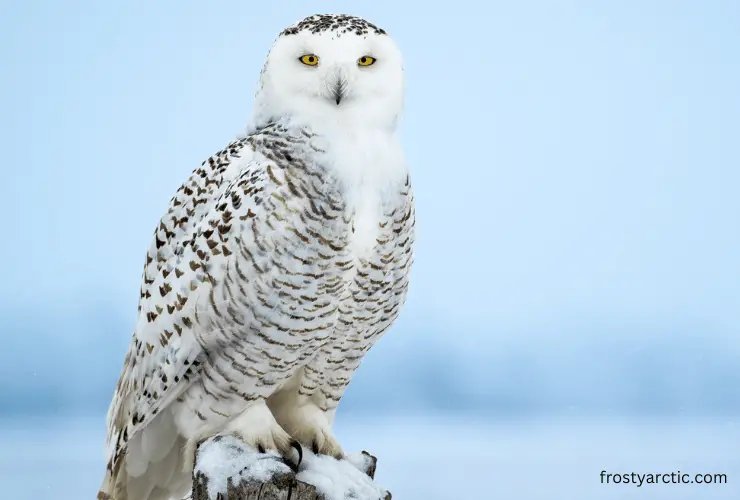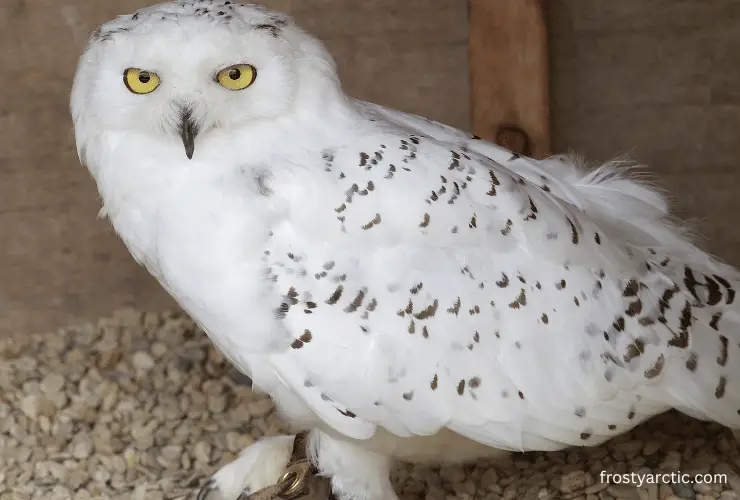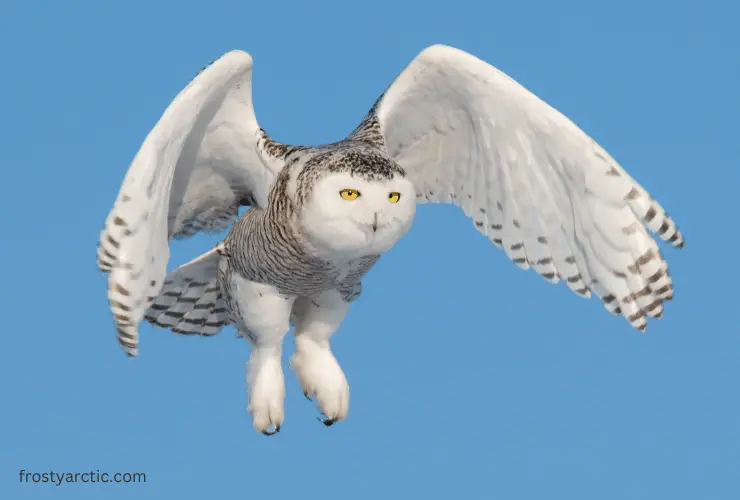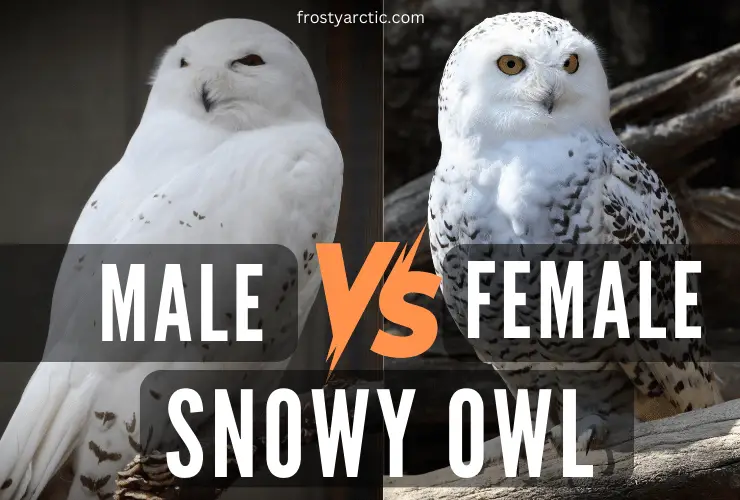Male snowy owls and female snowy owls look like twins at first glance. However, they are not the same. They are totally different due to their unique physiques and behaviors. One of the notable differences is the size. Female snowy owls are bigger in size as compared to male snowy owls. Plus, females have more capacity to survive in harsh temperatures than males.
But both males and females have more differences than just their appearance. Did you know that male snowy owls migrate more toward other places as compared to females? The length of males is 25 inches and 27 inches for females. What about their wingspan differences? The wingspan of both genders is mostly the same.
Do you know which gender is more dominant? How do you tell whether the snowy owl visiting your hometown every year is a male or a female? The colors of males and females are also unique; both are not entirely white.
Let’s see the different features and behaviors of male snowy owls versus female snowy owls. In this way, we can discover the unique traits that set males and females apart and also the similarities that deceive our eyes about their genders!
Male Snowy Owls Vs Female Snowy Owls: A Quick Comparison
Here is a quick comparison table between male and female snowy owls. It gives a first glance into the similarities and differences between both sexes:
| Parameters | Male Snowy Owls | Female Snowy Owls |
| Genus | Bubo | Bubo |
| Habitat | Arctic tundra | Arctic tundra |
| Speed | 46 to 50 miles per hour | 46 to 50 miles per hour |
| Shape | Smoothly rounded heads and bulky bodies | Smoothly rounded heads and bulky bodies |
| Overall Size | Smaller Size | Larger Size |
| Length | 25 inches | 27 inches |
| Weight | 2 to 5 pounds | 3 to 6 pounds |
| Color | Pure white | Less white color / black and white color |
| Marks and bars | Less wide and lighter marks and bars | Wider and darker marks and bars |
| White bib | Larger white bib | Smaller white bib |
| Lifespan | Up to 28 years | Up to 30 years |
| Tail Bars | Have up to three tail bars | Have up to six tail bars |
| Pellets | Regurgitate fewer pellets | Regurgitate more pellets |
Physical Differences
Here are a few key differences between the physical bodies of a male and a female snowy owl: ~ Source


1. Color Difference
Male snowy owls are purely white and they have light brown or black bars on their tails, nape, and back. On the other hand, female snowy owls are not purely white. They are a little bit pale or brownish. Their darker and wider bars are also prominent on their napes, tails, and backs.
In simple words, let’s quote the research of TheCornellLab from the All About Birds report: ~ Source
“Males have white plumage with scattered black markings. Females have a mix of white feathers with varying degrees of black or brown barring. Their pepperoni-type appearance provides them better camouflage during the nesting period.”
This is one of the major physical differences between a male and female snowy owl.
Important Note to Read: Adult male snowy owls and female snowy owls are not easy to recognize. This is because adult snowy owls take years (almost 2 to 3 years) to mature. During their juvenile period, they have dark bars all over their bodies. It takes time for those bars to disappear and turn completely white.
So, immature males may look similar to females. However, they are smaller and have fewer black bars than adult females. But juvenile females have heavy dark bars all over their bodies except under the wings and faces.
2. Unique Bib, Nape, and Bars
The extent of the white bib of a snowy owl can help a lot to find the sexes of these birds. Males tend to have larger white bibs, but it is important to check that their heads are balanced so you can distinguish the differences. The females have smaller white bibs.
Still, do you need clarification about separately labeling them according to their sexes? Do we have other physical differences? Yes, of course! The nape of the neck is dark in females, while it is white in males. Also, females have complete or nearly complete bars on their tails. Ok, what about male snowy owls? Males have nearly complete or broken bars on their tails.
3. Size Difference
Here is a completely shocking and perplexing fun fact about the sizes of both sexes. Guess what? Males are smaller in size as compared to females. This is a little bit confusing because, in most creatures, males tend to be larger. But here, females are bigger than males. The reason is sexual dimorphism. ~ Source
The length of female snowy owls is 27 inches.
On the other hand, the length of male snowy owls is 25 inches. Their wingspan is mostly the same, ranging from 4 to 5 feet.
However, females often have a slightly larger wingspan of up to 5.2 feet. Their big sizes make them commonly counted as one of the largest birds in the world.
4. Weight Diversity

Female Snowy Owls are heavier than male snowy owls. Males typically weigh between 2 and 3 kilograms (3 – 5 pounds). However, females can reach weights of 2.3 to 3.5 kilograms (5 – 6.6 pounds) or sometimes even more.
The one-pound extra weight of female snowy owls makes them the dominant member of their family. They also do not migrate so far as they don’t feel the need to check other places. Their heavy bodies store more energy than males.
5. Facial Disks
The facial disk is one of the distinct facial features of snowy owls. Female Snowy Owls have broader and larger facial disks compared to males. This is an amazing facial feature that helps enhance their hearing abilities.
Also, it provides insulation against cold temperatures. The female’s facial disk’s broader shape helps direct sound toward the ears. As a result, it improves their ability to catch prey. Not just this, females have more dense feathers within their facial disk than males.
6. Tails and Wingtips

Male snowy owls typically have longer tails than females. Their tails are slender and straight. However, the tails of females are shorter and more rounded. Moreover, females’ tails have dense feathers as compared to male snowy owls. Let’s see how the wingtips are different in both!
Female snowy owls have dark wingtips. As a result, when they fly, their wings have a barred appearance. On the other side, male snowy owls have whiter wingtips with less distinct barring.
7. Bill and Claw Size
Females are bigger than males, so, apparently, they have larger and more robust bills compared to males. This may aid in capturing and handling larger prey.
Females also tend to have larger and stronger claws. This adaptation helps them grasp and hold onto the prey more effectively and easily.
8. Neck Size
One of the key physical characteristics that separate male and female snowy owls is neck size and shape. Females have thicker necks than males. This can be attributed to their larger overall body size.
Last but not least, female snowy owls have more dense feathers all over their bodies than males. This gives them better insulation on colder days and nights. Likewise, it ensures their nests remain well-protected and warm.
All the above-mentioned physical differences are the major clues that distinguish between both genders of snowy owls. We do, however, have more subtle distinctions up our sleeves. Let’s look at them below.
Behavioral Differences
One of the simplest ways to distinguish between snowy owl genders is through behavioral differences. However, birdwatchers and observers have found many distinct behaviors. Let’s call them behavioral differences between male and female snowy owls. So, follow the blueprints and learn something new!
1. Courtship Display

According to the report of the Peregrine Fund organization, “Courtship Display” is a clear-cut behavioral difference. If you ever see a snowy owl showing courtship displays, it is a male snowy owl. Snowy owl males are constantly attempting to impress their female partners with a flawless display of flight. They attempt to take off in a bouncy or moth-like manner.
Have you noticed their V-shaped wings during the take-off flight? This is their distinct performance. They hold up their wings in the air that look like the shape of V. No matter if the prey is in their bill, they will do these actions more elegantly.
The males do not end their show here. They continue it until they land near their potential partner while dropping the prey near them.
Moreover, they proceed to parade proudly around the female. They maintain a turned posture, with their backs directed towards the females. The females then approach them if they feel interested. ~ Source
2. Territoriality and Defense
A nomadic lifestyle is more common among males. However, female Snowy Owls always try to defend and make their territories safe from other predators, more likely males. Males are nomadic and they are more active during the breeding season. ~ Source
They will do anything to protect their breeding territories. Sometimes, it costs them their lives while fighting against predators. They show fierce behavior to protect the chicks and nests. Their fights are against the biggest animals, mostly bears, foxes, and wolves.
However, females are more open in terms of attacking intruders. But, there are many exceptions when the males and females both try to defend their nests for their owlets and juveniles. Mostly, they work hand-in-hand! One parent does not take full responsibility for their offspring. ~ Source
3. Singing and Calls

The pitch and calls of snowy owls are also different. Males hoot more often than females. The hooting of females is louder due to their high-pitched voices as opposed to males. Female Snowy Owls also produce many other vocalizations. Let’s discuss them.
The most heard sounds are mewing calls and screams in order to solicit the food given by their males. These particular sounds are not created by males. Moreover, female snowy owls also make a unique grunting call while residing in the nests.
Male snowy owls have a higher-pitched and more melodious call. Females produce lower-pitched calls. Their calls are often described as harsher than males. So, listen to them carefully and enjoy the difference!
4. Nesting and Feeding Behavior
Snowy owls are recognized as monogamous when it is their breeding season (February or November). However, research also says that male snowy owls often select a new life partner every year. This behavior is not common in all-male snowy owls.
But, females do not change their partners. Although female snowy owls are very monogamous in this regard, a male snowy owl can have relations with two females in one season. Let’s differentiate how their behaviors differ in terms of nesting and feeding.
All snowy owls are lazy! This is true because they don’t like to put effort into making their own nests. They can snatch or take over the nests of other birds. Even on solid or bare ground, females can lay their eggs. The difference is that females are a little bit more possessive when it comes to caring for eggs and owls.
Dig The Nest Bowl! Literally, female snowy owls do this. If you ever see a snowy owl digging soil, that would be a female snowy owl. She does this great job with the help of claws and bills. Snowy Owls do not add any extra nesting material like other birds do. You will only find grass, moss, and feathers in their nests.
Brood Patch of Female Snowy Owls
According to a study, female snowy owls mostly have a unique brood patch in the breeding season. This conspicuous bare patch of skin on their ventral areas is one of their distinguishing features. It helps to differentiate between a male and female snowy owl in the summer without giving it a second thought.
Female Snowy Owls also do not leave their nests in hazardous situations and bad weather. Their eggs could crack or freeze due to the cold, so the females do the extra job by not leaving eggs alone! The male delivers food to her to feed chicks. She can also pile up stocks of uneaten food for future use!
5. Movements and Migration Differences
We are all aware of the snowy owl’s migration patterns. However, their migrations and movements towards other countries are highly disruptive. Moreover, this is their irregular migration. Often, they do not migrate, even if it’s hard to survive in the Arctic region.

But how do movements differentiate their sexes? The research article on ResearchGate Forum gives an in-depth report on this. In many years or due to periods of irruption, a large number of birds, including snowy owls, visit more than 48 Lower states.
They may also move towards California and Texas and even farther towards the north of the Mideast and New England. Here is an interesting fact! More females stay further north. Males and young owls do not remain there. But females like to stay within or near their natal territories. ~ Source
Choice of Daytime Roost Sites
Only male snowy owls roost in forests. However, females roost more often in open areas like fields and grasslands. This is a significant difference between both genders of snowy owls.
The reason is: males are mobbed in open areas. That’s why they prefer forests. According to the study, male snowy owls are less likely to be mobbed in forests than in open areas. In simple words, the mobbed frequency is lower in forests for males.
6. Hunting Techniques
Male snowy owls like to have a sit-and-wait hunting strategy to catch their prey. They also prefer to save their energy by roaming and finding prey. In fact, they patiently observe and ambush prey from a stationary position.
On the other hand, female snowy owls are more likely to engage in active hunting. They are mostly busy actively scanning and patrolling their territories in search of prey.
Who Hunts Bigger Animals
Another hunting difference between both sexes is also found. Here it is!
Female snowy owls are larger and that’s why they hunt larger animals. Males like to hunt lemmings, rodents, and small mammals. Contrarily, female snowy owls can hunt weasels like Mustela and Jackrabbits like Lepus.
Thus, females can take large prey. Additionally, female snowy owls can steal partridges (Perdix perdix), ducks (Anas spp.), rabbits (Oryctolagus cuniculus), Bucephala clangula, and Aythya species.
7. Choice of Perch Sites
Who chooses higher perch sites? Male snowy owls! They prefer high perch sites as compared to females. Moreover, their perch sites are more than 5 meters above the ground. Also, they do not hunt their prey from near the shorelines.
Their preferred roosting locations are usually near the water. Still, they do not hunt along the shorelines. Mostly, female snowy owls are seen hunting prey along the shorelines.
FAQs
Are white owls female?
Yes, white owls are females. However, males are generally whiter than females. So, whenever you see a purely white owl, the high possibility is that “it could be a male snowy owl“.
Females are usually pale white or black and white. When male snowy owls get older, they become whiter, while females do not change their color.
How big are male snowy owls?
Male snowy owls are bigger than other birds but not bigger than female snowy owls. They are typically measured between 20 and 25 inches from head to tail. However, this body measurement does not include the length of their extended wings or tail.
Their wingspan is 40 to 50 inches, and they weigh between 3 and 5 pounds. They are known as one of North America’s largest species of owls. If we combine four large birds, still they will not be equal to one male snowy owl.
What does the female snowy owl do?
Female snowy owls do a lot more work than males. She prepares the nests and incubates the eggs. She uses her body’s warmth during the incubation period to keep the eggs at an optimal temperature. Also, she feeds the little owlets. However, male snowy owls also participate in taking care of chicks.
He defends their homes and territories. Also, he brings in food for the kids. Both work together to take care of their kids. As the chicks mature, both parents introduce them to hunting skills and provide protection and guidance during the fledgling stage.
Do male snowy owls live longer than females?
Male snowy owls do not necessarily live longer than female snowy owls. Typically, the average lifespan of both genders is 10 to 25 years. However, some records show a female lives longer than a male. In history, once a female lived more than 30 years.
The lifespan of snowy owls can be influenced by many factors. For example, predation, reproductive success, and environmental conditions. Both males and females face similar risks and challenges in their habitat. So, there is a significant difference in their lifespan.
Can we get confused about snowy owls with similar species of owls?
Yes, you can get confused about snowy owls with other similar species of owls. Barred Owls are one of the species of owls that are similar to snowy owls. Leucistic (white) Great Horned Owls are also mistakenly recognized as snowy owls. These birds can fool you with their appearance, especially when their ranges overlap.
Does distance impact the color of snowy owls?
Absolutely yes. Distance is the major factor that directly implies the color of a snowy owl. If you see them from a large distance, they will not be easily recognized as males or females. However, females look gray if you see them from a distance. Both genders also have a great camouflage ability to blend in with the color of their surroundings, like the white color of snow, the brown color of soil or tree trunks, and so on.
Do male snowy owls have different eye colors than females?
No, male and female snowy owls do not have different eye colors. Both males and females typically have yellow eyes. The eye color of snowy owls is not sexually dimorphic, like their body colors. Simply put, it means the eye colors do not vary between the genders.
Do male snowy owls have larger beaks than females?
Yes. Male snowy owls have larger beaks than females. This is an important sexual dimorphism in snowy owls. The larger beak size in males is believed to be related to their masculine role of capturing and delivering prey to the female and their young.
Conclusion
So, are male and female snowy owls the same? No, they look the same because we don’t see them regularly. But if we pay close attention, we can see that they look different and obviously are different, especially the salt-and-pepper look that females have. It is often difficult to identify the genders of birds because they look the same. However, their sizes, shapes, colors, and patterns are the signs that help to find their gender.
A game of spot-the-difference is exactly like identifying the differences and similarities between a male and female snowy owl. I hope you find this article quite interesting after getting insights about the shocking differences. If you find any other distinguishing features between male and female snowy owls, you can share them with us.
Sincere Thanks for Reading!



1 thought on “Male vs Female Snowy Owls: What are the Differences?”